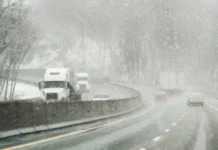 A new ICBC survey shows that nearly half (48 per cent) of all drivers surveyed plan to or already have put winter tires on their vehicle in anticipation of another heavy winter this year.
A new ICBC survey shows that nearly half (48 per cent) of all drivers surveyed plan to or already have put winter tires on their vehicle in anticipation of another heavy winter this year.
Significantly more Lower Mainland drivers reported being unprepared for driving in the conditions last winter as compared to drivers in other regions of the province. Lower Mainland drivers also reported they were significantly more nervous about driving in both snowy and icy conditions.
With last winter’s snowy and icy weather, serious crashes involving injury or death increased by 10 per cent in B.C. compared to 2015 due to drivers going too fast for the road conditions.
Almost half of those surveyed (47 per cent) witnessed a crash during the winter weather last year and one quarter admitted to experiencing at least one ‘near miss’ on the road.
In the Lower Mainland, casualty crashes due to driving too fast for the conditions increase by 21 per cent every year as the weather worsens throughout fall.
Drivers’ top concerns this winter are other drivers who don’t slow down or adjust their driving and drivers who don’t know how to drive in snow and ice.
That’s why ICBC and police are appealing to Lower Mainland drivers to adjust their driving for the conditions they encounter. In bad weather, slow down, increase your following distance and allow extra travel time.
Police across B.C. are looking for drivers travelling at unsafe speeds.
Top challenges for Lower Mainland drivers this winter:
-
After last year’s severe winter, most drivers surveyed stated they had to add extra time to their daily commute and adjust their times of travel. When severe winter conditions arrive, consider alternatives – take public transit if possible, carpool with a confident driver whose vehicle is equipped for the conditions, take a taxi, work from home or wait until the road crews have cleared major roads. Sometimes the best option is to leave the car at home.
-
When driving in dark and rainy conditions, focus your full attention on the road and use extra caution when approaching intersections. It can be very difficult to see pedestrians and other road users when visibility is reduced.
-
Consider using your headlights whenever weather is poor and visibility is reduced – not only at night – to help you see ahead and be seen by other drivers. Keep in mind that daytime running lights usually don’t activate your taillights too.
-
When fog hits, turn your headlights on or use fog lights if it’s very foggy. Use your defroster to keep your windows clear and partly roll down a window for more visibility if you need it. Use the right edge of the road or road markings as a guide.
-
Heavy rain can seriously reduce visibility and make road surfaces more difficult to stop on. Make sure your wipers are in good condition, slow down and increase your following distance to at least four seconds.
-
Drivers surveyed were least confident when driving on icy roads as compared to snow and other conditions. Be aware of black ice when temperatures near freezing. If you notice ice build-up on your windshield, there’s likely black ice on the road. Black ice is commonly found in shaded areas, bridges, overpasses and intersections. Slow down and increase your following distance.
For detailed tips on how to drive in winter weather, visit icbc.com.












